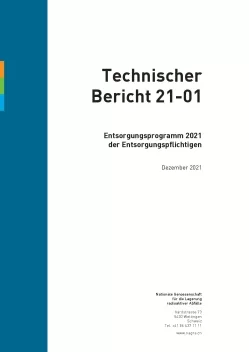
Technical Report NTB 21-01
Technical Report 21-01
This report documents the Waste Management Programme prepared by the Swiss waste producers in line with legal requirements. From the perspective of the waste producers, the objective of the Waste Management Programme is to provide a comprehensive presentation of the work required for disposing of all radioactive waste in Switzerland (strategic work programme), to identify the conceptual requirements and assumptions and to outline how these will be implemented in the design of the facilities and their stepwise construction.
The Waste Management Programme 2021 (WMP21) was prepared by Nagra on behalf of the waste producers; it is directed mainly to the authorities but also outlines how the waste producers have responded to conditions specified by the Federal Council and to further recommendations made by the authorities in relation to the Waste Management Programme 2016 (WMP16).
WMP21 is composed in such a way as to also be informative for the wider public. One important component is documenting the progress made in the Sectoral Plan for Deep Geological Repositories (SGT) since the previous version (WMP16) was published. Particular attention is drawn to the following:
- In concluding Stage 2 of the Sectoral Plan in November 2018, the Federal Council approved the decision to focus on the Opalinus Clay as the host rock for all repository types. Therefore, based on the suitability of this host rock from a safety perspective, it can be assumed for future project planning that the alpha-toxic waste (ATW) will be emplaced in the same repository as the low- and intermediate-level waste (L/ILW).
- At the same time, the Federal Council decided that the Jura Ost (JO), Nördlich Lägern (NL) and Zürich Nordost (ZNO) siting regions were to be investigated in more detail. Based on very close collaboration with the siting regions and cantons, the Federal Council also identified areas for locating the surface facilities and documented these in object sheets for Stage 2.
Extensive field investigations (2D and 3D seismics, Quaternary boreholes, deep boreholes) have been conducted within the framework of the ongoing Stage 3 of the Sectoral Plan, and preliminary results from these investigations confirm the fundamental suitability of all three siting regions.
- In many countries (such as France, Spain, the UK and the USA), L/ILW is disposed of in near-surface and comparatively cost-efficient repositories. In contrast, Switzerland has decided to pursue the more costly and complex option of deep geological disposal also for this waste category. With the focus on the Opalinus Clay as the host rock for all waste types, it is essentially possible to dispose of all waste in a so-called combined repository, which consists of both HLW and L/ILW repository sections. The results of the advanced field investigations confirm that all three siting regions provide sufficient space for a combined repository layout. This fulfils the same safety requirements regarding operational and long-term safety as two individual repositories, but also has clear advantages regarding construction-related risks, resource consumption and the emission of greenhouse gases as fewer facilities have to be constructed and operated at the surface and underground. Compared to two individual repositories, realising a combined repository is thus associated with operational, safety-related, ecological and economic advantages. For this reason, and if the conclusive overall safety-based assessment allows, the general licence application will be submitted for a combined repository.
- Nagra demonstrated in Stage 3 of the Sectoral Plan process that the areas at the Zwilag interim storage facility and the surface facility at the site of the deep geological repository are the only suitable and reasonable siting options for a spent fuel (SF) encapsulation plant; this position is also supported by a transregional working group.
- The time schedule has not changed since the beginning of Stage 3 of the Sectoral Plan process. The permitting procedure for the deep boreholes did not result in any legal delays that could have impacted the realisation plan and the underground investigations could therefore be carried out as planned. Nagra’s announcement of the site(s) for which it will prepare a general licence application for a combined repository or two general licence applications for separate repositories (in line with the Sectoral Plan) is therefore expected for 2022. At the same time, Nagra must specify where it plans to locate the surface infrastructure (including the site of the encapsulation plants).
- As in the past, the cost estimates for the repositories were developed in collaboration with external specialists and companies with extensive experience in the realisation of nuclear facilities and underground construction. The methodology used for the 2021 Cost Study (CS21) was based on the same methodology as that used for the 2016 Cost Study (CS16). Based on the results of CS21, the current cost estimate for the deep geological disposal is slightly lower than in CS16.
Shop
| hard copy, German | CHF 20,00 |

